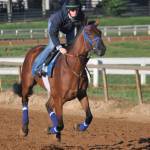Training Young Horses for Race Starts

Did you ever wonder how horses can stand so calmly in a racetrack’s starting gate? There are always quite a few other horses around, lots of people on the ground, other people climbing up in the gate, and some crowd noise that usually isn’t there while horses are out for early-morning training. Horses in gates near the rail must stand for several minutes while those in other post positions are loading. In the gate, each horse is standing in a small, enclosed space with another horse very close to him on either side.
As with other things horses are taught, starting gate procedures are introduced gradually and the horses learn to accept them through quiet repetition. Young racing prospects are first broken to saddle and then familiarized with running on a track at a training or racing facility. Gate training doesn’t start right away, though the first steps are established as the horses learn to be led, handled, bathed, and loaded into a trailer. If an open starting gate is set up near the stable, horses may be led or ridden through it as they go to and from the track. This allows them to become familiar with the apparatus, walking in quietly as part of the daily activities. When this becomes routine, the horses will progress though a series of small learning steps: standing still in the gate with the barriers open, standing in the gate with the back barrier closed, standing with both gates closed, having the gates opened and walking out. These steps will be repeated with and without an exercise rider until each procedure becomes routine and nonthreatening. Having an older horse along is a help if a young horse is reluctant at any point in its training. If the older horse willingly walks through the gate or stands with the barriers closed, the young horse gains confidence and stays calmer.
As gate training progresses, the young horses will be loaded side by side with another horse or two and asked to stand for a few minutes before the front barriers are opened, simulating race conditions. Even at this point, the horses will be asked to walk out and jog out many times before learning to jump out of the gate and pick up a racing pace. Because each horse is an individual, some will learn these lessons more quickly than others, but the most successful method is to give each horse the time it requires to stay calm. Rushing or forcing a young horse reinforces anxiety and nervous behavior that is often hard to overcome.
If a horse has had a frightening experience in or near the starting gate, he may develop a fear that keeps him from loading well. This can happen to horses at any age, and the solution is to go back to slow steps as the proper procedure is reinforced with calm repetition. If a horse acts up at the gate, he becomes a danger to other horses and people in the area, and the track starter has the authority to scratch the horse and require retraining before it is allowed to enter another race. Trainers of young horses consider that it is worth the time to establish the habit of loading and standing quietly in the starting gate. This calm training early in the horse’s career usually pays off throughout its racing days.








